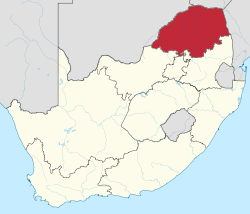Limpopo | |
|---|---|
| Motto(s): Peace, Unity and Prosperity | |
 Location of Limpopo in South Africa | |
| Coordinates: 24°S 29°E / 24°S 29°E | |
| Country | South Africa |
| Established | 27 April 1994 |
| Capital | Polokwane Lebowakgomo (legislative) |
| Districts | |
| Government | |
| • Type | Parliamentary system |
| • Premier | Phophi Ramathuba (ANC) |
| • Legislature | Limpopo Provincial Legislature |
| Area [1]: 9 | |
• Total | 125,754 km2 (48,554 sq mi) |
| • Rank | 5th in South Africa |
| Highest elevation | 2,126 m (6,975 ft) |
| Population (2022)[2] | |
• Total | 5,404,868 |
| • Rank | 5th in South Africa |
| • Density | 43/km2 (110/sq mi) |
| • Rank | 5th in South Africa |
| Population groups (2022) | |
| • Black | 96% |
| • White | 3.1% |
| • Indian or Asian | 0.5% |
| • Coloured | 0.3% |
| • Other | 0.1% |
| Languages (2022) | |
| • Pedi | 55.5% |
| • Venda | 17.4% |
| • Tsonga | 17.3% |
| • Afrikaans | 2.3% |
| • Shona | 1.6% |
| • Tswana | 1.4% |
| • Southern Ndebele | 1.1% |
| • English | 1.0% |
| Time zone | UTC+2 (SAST) |
| ISO 3166 code | ZA-LP |
| HDI (2019) | 0.710[3] high · 3rd of 9 |
| GDP | US$31.3 billion[4] |
| Website | www.limpopo.gov.za |
| Zulu | iLimpopo |
|---|---|
| Xhosa | iLimpopo |
| Afrikaans | Limpopo |
| Sepedi | Limpopo |
| Setswana | Limpopo |
| Xitsonga | Limpopo |
| Venda | Limpopo |
Limpopo (/lɪmˈpoʊpoʊ/) is the northernmost province of South Africa. It is named after the Limpopo River, which forms the province's western and northern borders. The term Limpopo is derived from Rivombo (Livombo/Lebombo), a group of Tsonga settlers led by Hosi Rivombo who settled in the mountainous vicinity and named the area after their leader. The Lebombo mountains are also named after them. The river has been called the Vhembe by local Venda communities of the area.[5] The capital and largest city in the province is Polokwane, while the provincial legislature is situated in Lebowakgomo.
The province is made up of three former homelands of Lebowa, Gazankulu and Venda and part of the former Transvaal province. The Limpopo province was established as one of nine provinces after the 1994 South African general election. The province's name was first "Northern Transvaal", later changed to "Northern Province" on 28 June 1995, with two other provinces. The name was later changed again in 2002 to the Limpopo Province. Limpopo is made up of three main ethnic groups: the Pedi, the Tsonga and the Venda.
Traditional leaders and chiefs still form a strong backbone of the province's political landscape. Established in terms of the Limpopo House of Traditional Leaders Act, Act 5 of 2005, the Limpopo House of Traditional Leaders' main function is to advise the government and the legislature on matters related to custom, tradition, and culture, including developmental initiatives that affect rural communities. On 18 August 2017, Kgosi Malesela Dikgale was re-elected as the Chairperson of the Limpopo House of Traditional Leaders.[6]
- ^ Census 2011: Census in brief (PDF). Pretoria: Statistics South Africa. 2012. ISBN 9780621413885. Archived (PDF) from the original on 13 May 2015.
- ^ a b c "Statistical Release - Census 2022" (PDF). statssa.gov.za. Retrieved 22 August 2024.
- ^ "Sub-national HDI – Area Database – Global Data Lab". hdi.globaldatalab.org. Retrieved 13 September 2018.
- ^ "Provincial gross domestic product:experimental estimates, 2013–2022" (PDF), www.statssa.gov.za
- ^ "Limpopo Province – An Overview". dolimpopo.com. Archived from the original on 1 February 2017. Retrieved 20 January 2017.
- ^ "Premier Stanley Mathabatha opens Limpopo House of Traditional Leaders, 26 Apr | South African Government". www.gov.za. Retrieved 16 August 2020.
